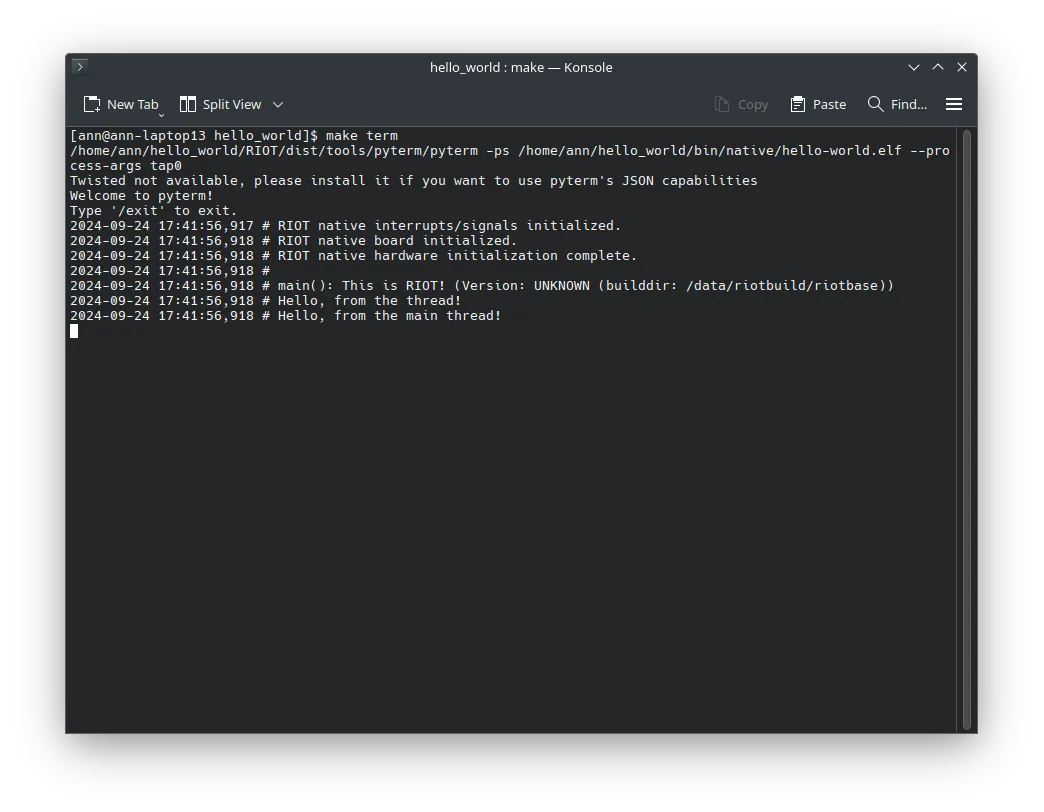Threads
Threads allow you to run multiple tasks concurrently in your application.
Step 1: Creating a Thread Function
Section titled “Step 1: Creating a Thread Function”To create a thread in RIOT,
you need to define a function that implements the thread and then start the thread.
The signature of the thread function should be void *thread_function_name(void *arg).
The argument arg is a pointer to any data that you want to pass to the thread.
Let’s create a simple thread that prints a message to the console.
Go into your main.c file and add the following code:
void *my_first_thread(void *arg){ /* The argument we receive will not be used */ (void)arg;
/* We print a simple message from the thread */ puts("Hello, from the thread!");
/* We return NULL to indicate that the thread has finished */ return NULL;}This function takes a single argument, a pointer to any data, and prints “Hello, from the thread!” to the console. Now all that is left is to start the thread.
Step 2: Starting the Thread
Section titled “Step 2: Starting the Thread”To start a thread we need two things:
a stack for the thread and a call to thread_create.
First, we need to define a stack for the thread.
The stack size should be at least THREAD_STACKSIZE_MAIN bytes.
You can define the stack as a global variable
or as a local variable in your main function.
The stack size can vary depending on the complexity of your thread. For example, depending of the amount of local variables you use, the stack size might need to be larger.
Let’s define the stack as a global variable:
char my_thread_stack[THREAD_STACKSIZE_MAIN];Lastly, we need to actually start the thread.
Go into your main function and include the following code:
int main(void){ /* Create a thread with the stack we defined above */ thread_create(my_thread_stack, sizeof(my_thread_stack), THREAD_PRIORITY_MAIN - 1, 0, my_first_thread, NULL, "My first thread");
/* The main thread can continue doing its work (e.g., printing a message) */ puts("Hello, from the main thread!");}thread_creates takes the following arguments:
my_thread_stack: The stack for the threadsizeof(my_thread_stack): The size of the stackTHREAD_PRIORITY_MAIN - 1: The priority of the thread0: The flags for the threadmy_first_thread: The thread functionNULL: The argument for the thread function"My first thread": The name of the thread
The final code should now look like this:
#include <stdio.h>
#include "thread.h"
/* * Define a stack for the thread. * The size of the stack is defined by THREAD_STACKSIZE_MAIN. */char my_thread_stack[THREAD_STACKSIZE_MAIN];
void *my_first_thread(void *arg){ /* The argument we receive will not be used */ (void)arg;
/* We print a simple message from the thread */ puts("Hello, from the thread!");
/* We return NULL to indicate that the thread has finished */ return NULL;}
int main(void){ /* Create a thread with the stack we defined above */ thread_create(my_thread_stack, sizeof(my_thread_stack), THREAD_PRIORITY_MAIN - 1, 0, my_first_thread, NULL, "My first thread");
/* The main thread can continue doing its work (e.g., printing a message) */ puts("Hello, from the main thread!");}Step 3: Building and Running the Program
Section titled “Step 3: Building and Running the Program”Now that we have created our thread, we can build and run our program.
Compile the program and flash it to your board using make flash.
If we now look into the terminal via make term we should see the message
“Hello, from the main thread!” printed to the console followed by
“Hello, from the thread!” printed by the thread.

Conclusion
Section titled “Conclusion”Congratulations! You have successfully created and started a thread in RIOT. Threads are a powerful tool but remember that you are on a resource-constrained device, so don’t create too many threads or use too much stack space.